Erin Driessen – 24 September, 2012
The pipe motif, a swirl of tiny ships whirring around a large “node” or egg, a resin cast kina, the hanging tentacles: all conjure images of time portals and wormholes. The viewer can imagine themselves projecting forwards or backwards through time, into fiction. Moby Dick is here, Medusa too; and at one point when the electric tentacles moved and I looked up, and heard the muffled sound of the ocean from one of the videos, I was Pinocchio inside the whale.
Dunedin
James R. Ford
Snake Pis
Hayden Prujean and Carlos Wedde
Deep Sea Dis-comedusae
29 August - 29 September, 2012
Although they are two quite separate exhibitions, James R. Ford’s Snake Pis, and Deep Sea Dis-comedusae by Hayden Prujean and Carlos Wedde both attempt to address existentialist themes of endlessness, change or flux, and properties of the universe. Both displays explore a wide range of media, from digital prints and gummy snakes to electronics and readymade objects. Ford’s Ouroboros snakes are mirrored by Prujean and Wedde’s vortices; each motif is repeated throughout each exhibition respectively.
The amount of work that has gone into Deep Sea Dis-comedusae is incredible. Prujean and Wedde have created paintings, electronic tentacles with motion sensors hanging from the ceiling, plaster and resin casts, videos, multimedia sculptures or installations, and painted model ships. They also made a small booklet, entitled “Merchant Ships,” to accompany the exhibition. It includes reproductions from past publications, such as information on ship models, funnel legends, advertisements for books, and a list of ships sold for breaking up. Throughout, Prujean and Wedde have added pages of their own. One gives an etymological definition of the word ‘nostalgia’; one recounts a story of a trial, at the end of which it was decided that a whale was in fact, a fish. The last page contains an excerpt from “The Vortex,” a prose-poetry piece by American writer Eliot Weinberger:
The Cartesian universe is mainly matter, is endless and the whole universe is literally in flux, in a kind of fluid. Within it are infinite worlds revolving around their suns, each world and sun spinning, and within them infinite vortices of matter, one within the other, to the infinitesimally small. Emerson wrote that Descartes “had filled Europe with the leading thought of vertical motion as the secret of nature.” Newton, in old age, complained bitterly that despite his proof that gravity moves the worlds, people still believed Descartes simply because Descartes had said it.
Weinberger went on to speculate that maybe it was because the image and idea of the vortex was more beautiful in imagination than gravity was in reality.
The spiral pipe motif is semi-explained in framed photocopies from the work of Victor Schauberger. By displaying Schauberger’s work, Wedde and Prujean draw attention to pseudoscientific theories like vertical motion and implosion. The spiral pipe was, according to Schauberger, a “water-ennobling device,” wherein the water must be able to in-roll on itself, and be able to breathe while travelling through the pipe. Therefore, it must also be possible to accelerate movement of the water. Wedde and Prujean have taken Schauberger’s pseudoscientific theories and merged them with their own imaginary visions of exploration and discovery. The idea of the vortex and the image of the pipe give these works an element of movement, but not just in an animation sense. The pipe motif, a swirl of tiny ships whirring around a large “node” or egg, a resin cast kina, the hanging tentacles: all conjure images of time portals and wormholes. The viewer can imagine themselves projecting forwards or backwards through time, into fiction. Moby Dick is here, Medusa too; and at one point when the electric tentacles moved and I looked up, and heard the muffled sound of the ocean from one of the videos, I was Pinocchio inside the whale.
The snake in Ford’s exhibition, like Prujean and Wedde’s vortices, appears in different guises: figurative, digital, edible, stuffed. Seven prints show the same black-and-white starry background, with a different-coloured ouroboros juxtaposed on each. The colours of the snakes correspond to the seven colours of the rainbow, but instead of putting them in the conventional order of ROYGBIV, Ford has arranged them backwards, with violet as the first (or last) colour: IBGYORV. This clearly expresses an idea of infinity (the eternal cycle) and beginnings as ends, and vice versa. The skin of each snake is printed with small markings that when looked at from further away, create larger numbers: the numbers of pi.
The accompanying text for Ford’s work explains that the first Snake Pi “was born from the idea of quantum mechanics - the way that particles can pop in and out of existence, taking on unobservable random forms and assemblages of molecules. Or, put another way: if you kept coming across a snake an infinite number of times, in at least one of the instances it would be curled into the shape of the pi symbol.” Ford has created that instance with Snake Pi (version 1ii), a stuffed toy snake, blue with white printed skulls and plastic eyes, curled into the pi symbol. On one wall, a projected animation plays the old Nokia digital snake game. The snake gradually makes and unmakes itself in the shape of the pi symbol. Between the stuffed snake on the floor and the digital one on the wall, sits a set of scales on a plinth, holding a mass of gummy snakes which initially weighed 3.14 kilograms, before its gradual disappearance through the consumption of spectators.
Although I like the aesthetic of the scale and gummy snakes, and the idea for using the old Nokia game, Ford’s show lacks a certain depth. For an exhibition that aims to express the randomness of the universe, it is a bit contrived. The snakes weighing 3.14 kilograms, the snake skin made up of numbers, the stuffed snake being 3.14 metres long, the digital animation running for 3.14 hours: we get it. I guess the repeated instances of pi in different forms express the eternal cycle, and the mixture of different media expresses randomness, but its incohesiveness has backfired. Instead of prompting depth of thought in the viewer on what this all might mean or point to, it comes off as surface - the snake, and pi, and again.
Erin Driessen
Recent Comments
Carlos wedde
Thanks for the review, it was interesting to read the way you saw the show in parallel to the themes ...
James R Ford
...not that I'm saying by listening to me I can help you with your kingdom, but that the obvious references ...
James R Ford
I don't really do subtle. Court jesters weren't subtle in their appearance and manner but you would be a fool ...
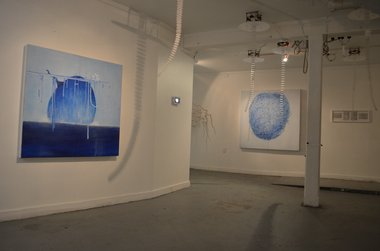

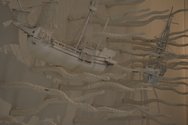

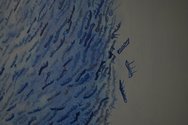
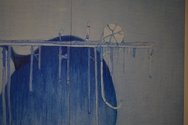
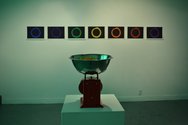
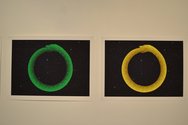
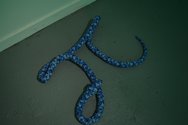

 Advertising in this column
Advertising in this column Two Rooms presents a program of residencies and projects
Two Rooms presents a program of residencies and projects
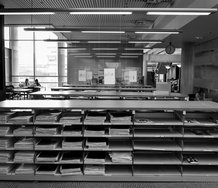

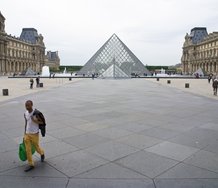
This Discussion has 5 comments.
Comment
James R Ford, 9:19 a.m. 24 September, 2012 #
Hi Erin! You mentioned that you were interested in my feedback and defences so here you go...You say that there is a lack of depth and that the point is overdone with repetition, stating “we get it” in a negative manner. But the point IS the repetition, so to offhandedly say you get it shows you actually missed the point. For me, Baldessari's best works were the paintings he commissioned Sunday painters to do of his hand pointing ay things, stating that all art does is point at things. I think the Snake Pi works point at something very interesting, which you touch on. What you missed is that my “contrived” selection of materials and consistent value were chosen as they are fundamentals of the world around us - physical dimensions, mass, energy and time, alongside a true random value that is intrinsic to rotational calculations, be them macro scale planet orbits or the micro behaviour of particles. The floating snakes in space were not ordered as a backward rainbow but, as their title suggests, in reference to the spiritual Seven Rays which are based around re-birth and cycle. In the other works there is a use of childlike materials and processes - toys, games, and sweets: a cycling of past experiences now re-contextualised. The sweets and their depletion is a simple demonstration of the relationship between mass and energy, the principle of how the universe is thought to have begun and the reason for its possible demise, snakes and all.
Erin Driessen, 10:45 a.m. 24 September, 2012 #
Thanks James, I think your comments really add something here.
There was a power chord unintentionally left in the corner, still plugged into the wall, curled in the shape of the infinity symbol; that signaled to me a kind of subtlety that was missing from your show. Although it was astutely pointed out to me that the fact that I appreciated the randomness of the power chord demonstrates that your show succeeded. And I didn't hate it. I just thought that maybe the snake and pi could have been more overarching themes rather than explicitly there in each piece. Where Prujean and Wedde used one or two motifs in loads of different ways which created a 'garden of forking paths,' your pieces appeared as separates.
James R Ford, 11 a.m. 24 September, 2012 #
I don't really do subtle. Court jesters weren't subtle in their appearance and manner but you would be a fool not to listen carefully to what they were saying...
James R Ford, 11:05 a.m. 24 September, 2012 #
...not that I'm saying by listening to me I can help you with your kingdom, but that the obvious references might deserve a second look
Carlos wedde, 3:47 p.m. 5 October, 2012 #
Thanks for the review, it was interesting to read the way you saw the show in parallel to the themes of infinity, change, flux...process - we felt that we were making a show that evoked a real environment but was a playful departure, we ended up a long way from our source stories, the show did end up revolving around the motifs you mentioned. The Cartesian vortex is a peculiar image of incessant change in the material world, but is largely at odds with the idea of Cartesian dualism - or conceptual certainties of observed phenomena.
Schauberger was kind of an anti-globalisation technologist in that he sought to make devices which relied on energy generated by implosion rather than explosion. He believed that combustion was fundamentally damaging as it agitated oxygen molecules and caused them to release carbon in a crude form into the environment, his world view was unusual at the time ( 1920 -1950 ish ) but interesting within the advancing expansion of the modern world. He represented an ecological element in the show, like a bit of lost treasure...
We did bury other bits and pieces in there to do with shipping and how industry has crowded out the myth of the ocean as a place where "infinity" can be found. This translated into some of the paintings - as painting has also been a place where artists have gone looking for infinity... I had fun making obsessive repititions around that idea.
Blue oyster is an interesting gallery to work in with its underground atmosphere and confined annexes. The show made an attempt at creating vistas within those confines, but that viewing would be interrupted by interaction with the kinetic tentacles - we hoped these would put people on their toes and prompt a need to interact as well as view, in a kind of b-grade movie way at least, we observed different responses to the Kinetic works as they explored the spaces visitors to the gallery occupied. There is a sort of scientific question in that gap between relating to and observing - the two activities are not mutually exclusive.
Anyhow that might all be too didactic, hope you took home a copy of "Merchant ships" and are on the lookout as to the comings and goings at your local port.
Participate
Register to Participate.
Sign in
Sign in to an existing account.